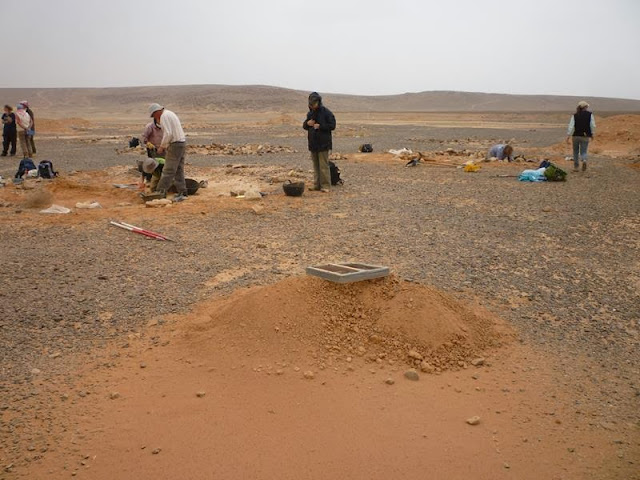This is the location of the station 1 stop further north up the Hijaz railway line from Wadi Rutm, where we paused briefly yesterday. This represents one of the largest static Ottoman camp sites we have investigated, consisting of two nearby sets of tent rings running alongside the side of the escarpment and the railway line,just before both dip down into what is effectively southern Jordan beyond.
The Ottomans were here for some time, and the camp sites finds are reflected in this with a significant number and variety of finds. The camps served to provide troops to defend the line and also to enable the passage of supplies of goods and equipment delivered to the station by train and then transferred by land over rocky climbing paths to the fort at Fassuah ridge which overlooks the huge wadi below.
 |
| GARP 2013 team investigating the tent rings in the North camp at Batn AL-Ghul |
The aim of the archaeological enquiry today was to expand the total assemblage of finds of this typical Ottoman army camp in an attempt to provide characterisation of the range of people and activities present during the conflict. Teams operated within hitherto un-excavated rings performing delicate extraction of the interior followed by sieving and finds collection.
At the same time the metal detecting team skirted the camp at a distance, hoping to find lost artefacts which again represented the activities of the soldiers present here.
In some of the images it can be seen that these tent rings were well formed, with substantial rock sides to hold down the canvas protecting the soldiers from the elements.
 |
| Modern tank scrape |
This continues to be a landscape of conflict, with modern tanks using the area for manoeuvres and firing practice. These scrapes are common here and right in the middle of the formation of rings. This further reinforces our desire to obtain as much valuable recorded information as we can while we have access to these sites and before they are trashed beyond the point of sensible investigation.
 |
| Sieving extracted sand to reveal finds |
For only the second time since we have been pursuing this project, the weather suddenly changed from warm to very stormy, with the consequence that we had to shorten today's activities and head home early. A significant electrical storm approached us from the west producing very high ionisation in the air where we were working, and thunder and lightning within a mile or so. As the rain increased we took the decision to abandon the day, and just everyone just about managed to gather and stow all the tools and jump into the bus before the heavens opened. Definitely the right decision as standing in the middle of an open plateau working with trowels and metal detectors in such conditions is not wise.
Some images of finds from today are below. These include an Ottoman officers personal seal, some coins, a headdress or shirt ornament, what we think might be an ornate caddy spoon made of copper and some tiny pieces of decorative metal with pins for attachment to clothing.
We are back here again tomorrow, with hopefully better weather and more exciting finds to share with you on this blog.


























Brilliant work and some stunning finds, well done Anna with the Ottoman seal WOW!!. Keep up all the good work guys, brings back many good memories. Cheers Jules
ReplyDelete